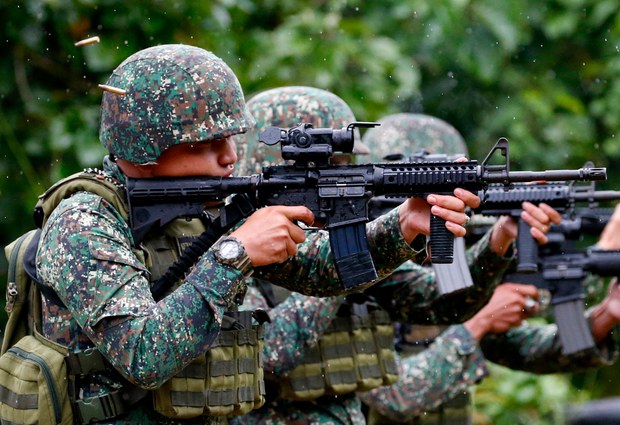Philippines: 2 Hostages Freed from Abu Sayyaf
2018.05.09
Marawi, Philippines
 Philippine marines fire at targets during the Mentor Training Team Program for Military Operation on Urbanized Terrain at the Gregorio Lim Marine Base, southwest of Manila, Dec. 18, 2017.
Philippine marines fire at targets during the Mentor Training Team Program for Military Operation on Urbanized Terrain at the Gregorio Lim Marine Base, southwest of Manila, Dec. 18, 2017.
The Philippine military rescued two hostages held by Abu Sayyaf while two policewomen remained in captivity more than a week after they were taken by the militant group, officials said Wednesday.
The gunmen abandoned Blas Jakosalim Ahamad near the town of Panglima Estino on southern Jolo island on Tuesday, a day after heavy fighting left at least 12 gunmen dead.
Another captive, Faizal Ahidji, was freed earlier. But there were no immediate sightings of policewomen Benierose Alvarez and Dina Gumahad, who were seized along with them near an army base on April 29.
The Abu Sayyaf had demanded a ransom of more than U.S. $96,000 (5 million pesos) for the captives, but it was not clear whether the civilians’ relatives paid for their release.
“Operations are ongoing to recover the two policewomen,” said Brig. Gen. Cirilito Sobejana, the local army commander, adding that Ahidji and Ahamad were being debriefed at an undisclosed military camp.
Sobejana said a small Abu Sayyaf unit led by a commander named Mujir Yada carried out the abduction.
In the nearby island of Basilan, government security forces said Wednesday that they had captured an Abu Sayyaf militant involved in the June 2001 siege in the city of Lamitan where two hostages were beheaded.
Senior Superintendent Rufino Inot, Basilan provincial police chief, said the suspect, Unjie Jammang (also known Dams), 50, was arrested at his hideout near the town of Maluso. He has a bounty of about $11,000 (570,000 pesos) on his head.
Jammang, according to Inot, took part in a June 2001 siege of Lamitan town in Basilan, when the gunmen snatched several local hostages. Twenty soldiers died in a gun battle and militants later beheaded two of the hostages, while the others were freed or escaped.
The Abu Sayyaf is the most brutal of militant groups operating in the southern Philippines. It was formed in the 1990s, and has been blamed for some of the worst terrorist attacks in the country, including the firebombing of a passenger ferry on Manila Bay that left more than 100 dead in 2004.
One of the Abu Sayyaf’s commanders, Isnilon Hapilon, would later pledge allegiance to the Islamic State and become its leader in the region. Last year, he led a five-month siege on the city of Marawi also in the south, leaving an estimated 1,200 dead.
Hapilon and key leaders of Marawi attack were killed in October 2017, ending the siege.
Richel V. Umel in Marawi contributed to this report.







